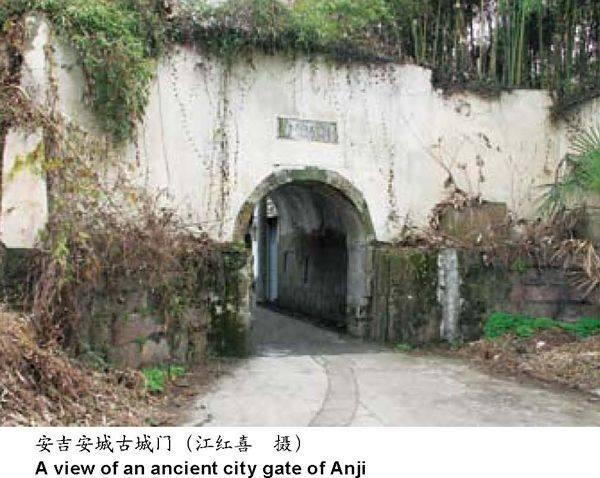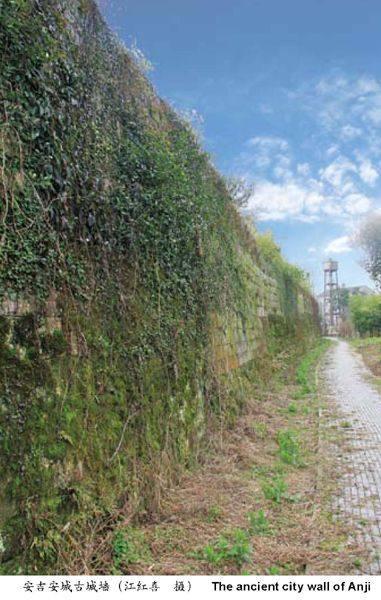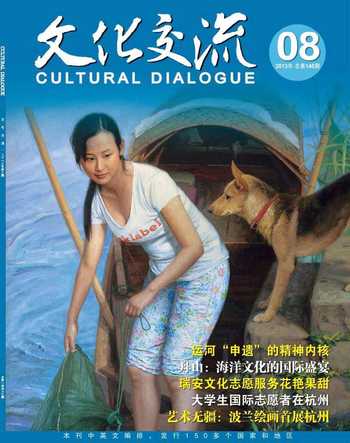湖州探古
2013-04-29韩晓露
韩晓露



真没想到,湖州原来那么古老,若不是前一阵子深度探访这座城市,还真不知道。
古安城
安城有一段爬满野藤的城墙,历经风雨却依然整齐而坚实。城墙外是一条深阔的护城河,河岸长满苔藓,河面漂着浮草。
安城始建于唐代开元年间,为安吉县治,当时无城郭,筑城在元末明初。
遗存的城墙绵延3000多米,有5米多高。安城古时有四处城门:东门迎春、南门朝阳、西门宝成、北门拱宸,有谯楼更铺。城墙当年的意义在于扎根土地、保护居民、防御山溪洪水、阻挡金戈铁马。明清时期城墙被多次修复。
事实上安城这块土地的历史久远得很。在汉代刘向的著述里,战国时期,有一位叫作晏子的外交家,与春秋初年的政治家管仲相提并论;晏子出使楚国那段著名故事,脍炙人口,流传至今,并且编入了中小学课本教材;据说,晏子娶了吴王的女儿,居住安城。
后来,这块土地上、这座古城里显然还发生了很多的故事……
安城渐渐颓废,虽存三门,可惜迎春门被人为拆去;所幸朝阳门已列入浙江省省级文物保护单位。
如今,我们在安吉县博物馆里看见了这块古老土地上先人的遗物。一种石质的工具,考证说出产于旧石器时代,时当于80万年前。一块龙形的玉佩,保存完好,典雅而不失霸气。它的主人肯定是一位贵族,因为玉石在古代原本就是贵器,更何况这是一块雕刻着龙的形状的配饰。还有一只瑟,仔细观察,还能看见留在其上的丝质琴弦。这种巨大的乐器,当年属于宫廷乐器中的一种,平素里很少见到。
最多的宝贝是铜镜。湖州曾是全国铜镜的主要产区,多出土于安吉高禹,那边地势高,可能是贵族墓地。这里展出的铜镜,比前段时间浙江省博物馆里专门的铜镜展还要多。听说,这些珍贵的器物深埋在地下那么多年,不少是因为地产开发而被民工随便一挖挖出来的。相信还有很多深埋地底,不为人知。
博物馆里的陈列展现的只是安城遗物的一小部分,但是安城的富庶繁盛已可窥见。
鄣吴村
鄣吴镇鄣吴村的吴昌硕故居是一座四合式的深宅大院,原有砖木结构的两进三间二楼的房子,现存一进,悬王个簃书写的“吴昌硕故居”的金字匾牌。平屋里有吴氏史迹展厅,陈列有《吴氏世系图》和明嘉靖朝“吴氏父子四进士”的墓碑。天井后面是主楼。中间堂屋上挂着吴昌硕嫡孙吴邺的《紫藤》图,两边是于右任撰、吴昌硕嫡重孙吴书的对联:“诗书画而外复作印人、绝艺飞行全世界;元明清以来及于民国、风流占断百名家。”
二楼东头是吴昌硕的书斋,书桌上安放着自制的刻刀和笔架。书房侧边开有一扇非常狭小的窗户。据说,当年吴昌硕每天一回家,就躲到楼上去,就着小窗之光,练书法习刻章。当地的乡邻给吴昌硕取了个绰号叫“乡阿姐”,说他足不出户就像大闺女。
故居里四散陈列着吴昌硕书迹的各种拓片。
吴昌硕故居边上有一座状元桥,还有半月池及门楼。
村里一位制扇艺人做向导,带我们去村扇子博物馆看他的一个绝艺:没有一个外露的钉子,而将扇子巧妙地整合起来。他告诉我们,鄣吴村现在是扇子生产大村,供应着全国近三分之一的扇子市场,连杭州王星记扇厂的扇子基础部分也是这里做的。
然后,这位制扇艺人带我们去看“大大鄣吴村,小小孝丰镇”。他介绍,宋代建鄣吴村之初,村民仅几十户,到清代已有五六千人之众,名望属建炎南渡的淮安吴氏为最,大凡宅第、牌坊、祠堂及陵墓等,多出吴门后代。我们在村里见到了吴昌硕的第五代孙吴申生,他现在是吴昌硕故居的讲解员,住在祖上曾经放粮的一个仓库里。
环村流淌着一条鲤鱼河。鲤鱼河是有由来的。据说,朱元璋路过鄣吴村,发现风水可能会出皇帝,就派通晓风水的刘伯温再度探访。刘伯温自知其意,来了后表面夸赞风景好,实在暗地里安排人坏了风水。而并不知情的当地人就把这河唤作“鲤鱼河”,意在表达这里可能会出现“鲤鱼跳龙门”者。果然,后来村里出了四进士,也出了艺术大师吴昌硕。至于帝王,倒是出在邻县长兴,叫陈霸先。
鲤鱼河宽仅1米多,一眼能望见河底的淤泥。村民说,淤泥底下是河床,一溜垒得非常整齐漂亮的鹅卵石。
扬子鳄村
湖州的古老还表现在扬子鳄身上。被称作“活化石”的扬子鳄,在长兴的一个村落里繁衍。
扬子鳄村实在太大了,有一个又一个养殖鳄鱼的池塘。我们坐上电瓶车观光游览。
目前,扬子鳄村一共有两期基地。基地四周树木繁茂,还种植了一大片红梅。养鳄池边上还有亭台楼榭长廊,别有一番情趣。
在二期基地里,有好多条扬子鳄从水里爬出来,趴在岸边晒太阳,一动也不动,远远地望去,就像巨大的塑胶玩具。偶尔有几条扬子鳄摇着尾巴,扑通一下滑入泥塘,激起一圈水花。
饲养员说,扬子鳄吃螺、蛙、虾、蟹、鱼及鼠、鸟等,遇上较大的猎物,会以粗硬的尾巴击打后食用。
扬子鳄已在这个地方扎根,据说最早只是一对。当地人喊它们为“鬼”,一般不敢惹它们,于是就没有去猎杀。后来,林业局的同志发现了,就在这里设立了一个基地。没想到经过若干年,现在居然有了1000多条。
扬子鳄要冬眠,于是,基地建立起有松泥的池塘小岛,扬子鳄会在泥土里面打洞。如果遇到游客嘴巴里发出“啪啪啪”的声响时,扬子鳄们就会因受惊吓而从泥地里费力地探出一个嘴巴尖来。
基地里还有其他的鳄种。比如来自泰国暹罗河的鳄鱼。这些鳄鱼一到冬天就要圈养在太阳能暖房里。而很多刚出生的扬子鳄就跟它们一起圈养,在冬日暖房里闭着眼睛晒太阳。
据说贵养扬子鳄,是因为它的卵会随着温度变化而孵化出不同性别的鳄鱼,而且鳄鱼身上还保留很多恐龙的特质。
怎么样才能使扬子鳄基地更加繁荣昌盛,这是让扬子鳄村村长一直伤脑筋的事情。
于是浙江省政府的参事就来了一个现场办公,开了一个小型会议。会议大致意思是在周边设立一个类似度假村的休闲场所,把附近的沪宁杭人吸引过来,然后再在村里搞点特色文艺活动;并且不妨将熊猫之类的另外“活化石”也引进一起饲养,以此来吸引更多的游客。
村长听了很受启发,说,接下去扬子鳄基地三期又要开出来了。
看来,“活化石”扬子鳄将会继续古老下去。
Tap the Secrets of Huzhou
By Han Xiaolu
Huzhou is unfathomably older and deeper than I thought.
The Ancient Town of Ancheng
The age-old city walls in the town remain neat and sturdy against the severity of time. Beyond the walls lies a wide and deep moat, with both sides covered by thriving moss.
The town was built in the Kaiyuan years of the Tang dynasty (618-907), under the jurisdiction of the prefecture of Anji at the time – without city walls. Fortification did not come until the early years of the Ming (1368-1644).
The remains of the city wall meander approximately 3,000 meters and rise five meters high. The town was safeguarded by four city gates on four sides in ancient times. The gates were known as Yingchun, Chaoyang, Baocheng and Gongchen respectively, intended against military invasion and flood. The gates went through renovation several times in the centuries of the Ming and Qing (1644-1911).
Legend has it that Yanzi, the most famous diplomat in the Warring States period (475-221BC) of China, once lived in the ancient town. Three gates have survived the decline of the city and Yingchun Gate was torn down. Fortunately, Chaoyang Gate is a cultural relic unit under provincial-level protection.
The life of the Paleolithic people can be relived now in the county museum. Copper mirrors constitute a prominent part of the museums collection. Huzhou is proud to have the countrys largest number of copper mirror findings. The Gaoyu area of Anji is believed to have been a major burial ground for noble families in ancient times, convincingly illustrating the ancient prosperity of the town.
Zhangwu Village
Zhangwu Village is home to the former residence of artist Wu Changshuo (1844-1927). Inside the courtyard compound is a two-storey brick and wood structure. The prominent seal carver and painter spent a lot of time in the study that is tucked away at the eastern end of the second floor, practicing calligraphy and seal carving. He was so house-bound that village folks fondly called him a ‘country girl.
Tablet rubbings on display in the house hint at the seal engravers lifetime accomplishments. Wu Shensheng, representing the fifth generation of the Wu family, now lives in the village and works in the former residence as a guide.
What also recommends the village is its fan-making industry whose output accounts for nearly one-third of the national total. The village is also a major supplier of fan frameworks for Wang Xing Ji, a time-honored paper fan label based in Hangzhou. A paper fan museum of the village highlights the manufacturing process and the villages fan-making tradition.
Many believe the fine cultural heritage of the village owes a lot to the Carp River. The river and its ‘fengshui caught the eye of Zhu Yuanzhang, the founding emperor of the Ming Dynasty (1368-1644), when he was passing through the village.
Alligator Village
For a deeper understanding about the historical charm of Huzhou, the more intrepid travelers can go to Changxing to see the menacing Chinese alligators in the Alligator Village.
The first two phases of the alligator farms in the village have been completed, presenting a lush view ideal for sightseeing too. The sinister reptiles can be seen leaning over the banks and enjoying sunshine. Watched from a proper distance, the alligators look as listless and still as huge plastic toys.
When the first two Chinese alligators were spotted by villagers, people were so scared that they called the reptiles ‘monsters and dared not kill them. The alligators finally found a home here after the local forestry administration set a special farm to encourage reproduction of the two newcomers. Now there are more than 1,000 alligators living on the farms.
Alligators make holes in mud ponds and isles and hide themselves there for hibernation. It is amusing to see how the ferocious-looking carnivores emerge from behind the mud and respond to tourists “pa-pa-pa sound like a scared child. There are many farms. It is fun to ride a battery-operated tour vehicle to tour around.
How to make the alligator village known to more people and to build a better home for the alligators has long been a headache for the village head, who has been thinking about launching the third phase of the alligator park. A feasible solution may be to add more leisure and recreational facilities to the village to attract more tourists from Shanghai, Nanjing and Hangzhou.
